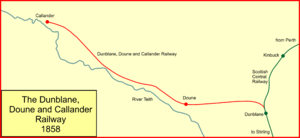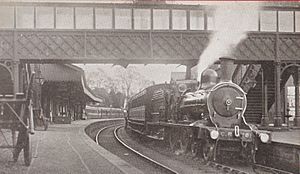Dunblane, Doune and Callander Railway facts for kids
The Dunblane, Doune and Callander Railway was a railway line in Scotland. It opened in 1858. Its main job was to connect the towns of Callander and Doune to the bigger Scottish railway network. Later, people wanted to build a railway all the way to Oban. Callander became the perfect starting point for this new line. From 1880, Callander was on the main route to Oban.
However, many railway lines were closed in the 1960s. This railway line closed down in 1965. Today, you can still get to Oban by train, but it uses a different route.
Contents
The Railway's Story
The Scottish Central Railway was given permission to build its lines on July 1, 1845. On the same day, the Caledonian Railway also got its permission. These two railways were planned to meet at Greenhill Junction. Together, they would connect major cities like Carlisle and Perth. Eventually, they would link London and Aberdeen into the railway system.
As they planned their lines, railway builders saw opportunities to expand. They thought extending lines through Callander to Dalwhinnie would be a good idea. In 1845, a company called the Stirling, Callander and Tillicoultry Railway suggested a grand east-to-west line. They described the towns it would serve in a very exciting way. But this plan never happened.
People in towns could clearly see the benefits of having a railway. It would make things like coal and lime much cheaper. Lime was important for farming. It also made it easier to get manufactured goods. So, people in Doune and Callander wanted their own railway branch line. Callander was a weaving village with about 1,671 people in 1861. The land was good for building a railway. The town of Dunblane was about 10 miles (16 km) to the east, along the River Teith valley.
In 1846, a new plan for the Dunblane, Doune and Callander Railway was put forward. This plan was more realistic, running from Dunblane. It received official approval on July 16, 1846. The company was allowed to raise £80,000. They could also lease their line to the Scottish Central Railway. However, 1846 was a tough year to find money for railway projects. Even with local support, not enough money was raised. So, this plan was put on hold.
The idea for the Dunblane, Doune and Callander Railway came back in 1856. A new law on July 21 allowed the project to go ahead. This time, they needed £60,000. The Scottish Central Railway really wanted to encourage this line. They hoped it could be a starting point for railways into the Scottish Highlands. They invested £13,400 in the project.
The railway line officially opened for trains on July 1, 1858. Tourism was very important to this line. In summer, there were five trains a day. In winter, there were two trains a day. This shows how popular it was for visitors.
The Scottish Central Railway operated the trains on this line. The Dunblane, Doune and Callander Railway company was later taken over by the Scottish Central Railway. This happened on June 29, 1865. Then, it joined with the Caledonian Railway on July 5, 1865.
Reaching Oban
The early idea of extending the railway from Callander into the Scottish Highlands seemed like a dream. But after the Callander line opened, these ideas grew stronger. The Callander and Oban Railway (C&OR) was then created. It was an independent company, and it used Callander as its starting point.
The C&OR often struggled with money. It finally opened to a station called "Killin" (later Glenoglehead) in 1870. The line eventually reached Oban in 1880. The original Callander station for the Dunblane, Doune and Callander Railway was at the eastern edge of town. It was near Stirling Road. This station was built for a short local line. It wasn't very good for a main line. So, the Oban company built a new, bigger station. It was located behind the Dreadnought Hotel. For a while, this was called Callander Dreadnought station. But this name was not used in train timetables. The old Dunblane, Doune and Callander Railway station became a place for storing goods.
In 1895, the train service included three trains. These trains went all the way between Stirling (and possibly Glasgow or Edinburgh) and Oban. There were also two shorter trains from Dunblane to Callander. A lot of goods and fresh produce were carried on the line. A passing loop was built at Drumvaich. This was halfway between Doune and Callander. This allowed trains to pass each other. The section between Dunblane and Doune was made into a double track in 1902. This helped more trains run at once.
Closing Down
The Caledonian Railway became part of the London, Midland and Scottish Railway (LMS) in 1923. Then, it became part of British Railways in 1948.
In the 1960s, a report suggested closing railway lines that were losing money. This led to what people called the Beeching cuts. This part of the railway line closed on November 1, 1965. Oban is still served by trains today, but they use a different route. A short piece of track remained at the Dunblane end. It served Springbank Mill. But when the mill closed, this last section also closed in 1971.
What Happened After Closure
| Overview | |
|---|---|
| Locale | Scotland |
| Dates of operation | 16 July 1846–29 June 1865 |
| Successor | Caledonian Railway |
| Technical | |
| Track gauge | 4 ft 8 1⁄2 in (1,435 mm) |
| Length | 10+1⁄2 miles (16.9 km) |
Some parts of the old railway track are now footpaths and cyclepaths. You can find these south of Doune and south of Callander. About a mile west of Dunblane, the A9 Dunblane by-pass road cut through the old track. In Dunblane itself, new houses have been built over most of the old line.
The station building at Doune was taken down in 1968. However, the old station master's house is still there. Houses now stand where the station was. The site of the original Callander station also has houses on it. The Callander engine shed, which closed in 1924, was demolished in 1974. The old goods yard at Dunblane is now a car park, a supermarket, and some sheltered housing.
Many of the bridges that went under the railway have been removed. But the stone bridge over the Keltie Water south of Callander is still there. Some metal bridges south of Doune also remain.
The Land and the Line
Even though the railway followed the River Teith, the land was challenging. The line had some steep slopes. From Dunblane, the line climbed for a mile at a slope of 1 in 107. Then, it went downhill at a slope of 1 in 105 to Doune. From Doune, the line steadily climbed to Callander. This climb had a slope of 1 in 127.
Connecting to Other Lines
The Dunblane, Doune and Callander Railway connected to:
- Scottish Central Railway at Dunblane
- Callander and Oban Railway



